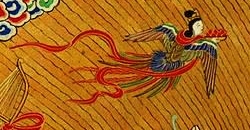Kalaviṅka
Kalaviṅka is a mythical creature with origins in Buddhist mythology, known for its exceptionally beautiful voice, which is often described as being capable of making divine music that reaches the ears of listeners from a great distance, even before they can see the creature. The Kalaviṅka is typically depicted as a bird with a human head or with a human-like face, embodying the fusion of avian and human characteristics in its artistic representations across various Asian cultures, particularly within Chinese Buddhism, Japanese Buddhism, and Tibetan Buddhism.
Etymology[edit | edit source]
The name "Kalaviṅka" is derived from Sanskrit, where "kala" means "sweet" or "pleasant," and "viṅka" is related to the term for a bird or a specific kind of musical sound. This etymology underscores the creature's association with melodious sounds and its role as a symbol of heavenly music.
Origins and Symbolism[edit | edit source]
The concept of the Kalaviṅka traces back to early Buddhist texts, where it is often mentioned in the context of the Pure Lands, paradisiacal realms that are free from the sufferings of the mundane world. The bird's song is said to inspire and remind listeners of the Dharma, encouraging them to pursue spiritual enlightenment. In this way, the Kalaviṅka serves as a metaphor for the spreading of the Buddhist teachings through appealing and harmonious means.
Artistic Depictions[edit | edit source]
In art, the Kalaviṅka is depicted in various forms, ranging from sculptures and paintings to temple decorations. Its representation has evolved over centuries, with some of the earliest depictions found in Central Asia, spreading to East Asia through the transmission of Buddhism. In China, the creature is often seen in the decorative arts of the Tang dynasty and Song dynasty, where it became a popular motif in Buddhist art. Similarly, in Japan, the Kalaviṅka is featured in traditional Nara period and Heian period Buddhist sculptures and paintings.
Cultural Significance[edit | edit source]
Beyond its religious symbolism, the Kalaviṅka has also been embraced in secular contexts, symbolizing joy, beauty, and the transcendence of the human spirit. Its image and the idea of its celestial music have influenced various aspects of Asian cultures, including literature, music, and the performing arts. The creature's ability to produce divine music that transcends physical boundaries has made it a symbol of the power of art and beauty to uplift and inspire.
In Modern Media[edit | edit source]
The Kalaviṅka has found its way into modern media and popular culture, appearing in literature, anime, manga, and video games. In these contemporary adaptations, the Kalaviṅka often retains its symbolic associations with beauty and ethereal music, while also being reimagined in new contexts that resonate with modern audiences.
Search WikiMD
Ad.Tired of being Overweight? Try W8MD's physician weight loss program.
Semaglutide (Ozempic / Wegovy and Tirzepatide (Mounjaro / Zepbound) available.
Advertise on WikiMD
|
WikiMD's Wellness Encyclopedia |
| Let Food Be Thy Medicine Medicine Thy Food - Hippocrates |
Translate this page: - East Asian
中文,
日本,
한국어,
South Asian
हिन्दी,
தமிழ்,
తెలుగు,
Urdu,
ಕನ್ನಡ,
Southeast Asian
Indonesian,
Vietnamese,
Thai,
မြန်မာဘာသာ,
বাংলা
European
español,
Deutsch,
français,
Greek,
português do Brasil,
polski,
română,
русский,
Nederlands,
norsk,
svenska,
suomi,
Italian
Middle Eastern & African
عربى,
Turkish,
Persian,
Hebrew,
Afrikaans,
isiZulu,
Kiswahili,
Other
Bulgarian,
Hungarian,
Czech,
Swedish,
മലയാളം,
मराठी,
ਪੰਜਾਬੀ,
ગુજરાતી,
Portuguese,
Ukrainian
Medical Disclaimer: WikiMD is not a substitute for professional medical advice. The information on WikiMD is provided as an information resource only, may be incorrect, outdated or misleading, and is not to be used or relied on for any diagnostic or treatment purposes. Please consult your health care provider before making any healthcare decisions or for guidance about a specific medical condition. WikiMD expressly disclaims responsibility, and shall have no liability, for any damages, loss, injury, or liability whatsoever suffered as a result of your reliance on the information contained in this site. By visiting this site you agree to the foregoing terms and conditions, which may from time to time be changed or supplemented by WikiMD. If you do not agree to the foregoing terms and conditions, you should not enter or use this site. See full disclaimer.
Credits:Most images are courtesy of Wikimedia commons, and templates Wikipedia, licensed under CC BY SA or similar.
Contributors: Prab R. Tumpati, MD

